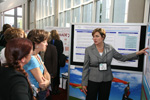36th Annual Meeting of the American Association of Diabetes Educators (Atlanta, GA, August 5-8, 2009)

by jessica swienckowski
In August we packed up our entire team and headed to Atlanta (popularly nicknamed “Hot-lanta”) for a conference we cannot help but have warm feelings about. This four-day meeting of diabetes educators and health care providers featured a packed seven tracks of breakout sessions, hundreds of exhibits, and several hundred posters, all geared to re-energize educators and help fortify them in their continuing fight on the front lines of America’s most costly epidemic. It was impossible to overlook the palpable sense of community at AADE—every corner we turned we would find pairs or small groups of educators sharing their stories, experiences, and advice with each other. While the conference certainly offered its share of amazing talks from big names in diabetes, it was inspiring to watch and listen in on the sharing and learning taking place in the hallways and lounges between talks or over lunch.
continuous glucose monitoring takes center stage
There was a clear focus on continuous glucose monitoring (CGM), with several dedicated sessions and packed conference halls. Educators seemed excited to learn how to use this tool to help their patients gain better, safer control. Although reimbursement for CGMs is continually improving, a big topic of discussion was how best to navigate the reimbursement environment to ensure CGM coverage for patients. In general, CGM garnered lots of support at this year’s AADE as a useful tool in combating hypoglycemia, controlling A1c, and measuring general trends in glycemic control. We hope that this support translates into even better reimbursement and greater clinical acceptance—we do note that despite all the recent advances, this product is still in its infancy, and we look forward to its growth and future innovation.
incretins rise up
 On the pharmaceuticals front, the incretins (GLP-1 analogs and DPP-4 inhibitors, such as Byetta, Januvia, and Onglyza) were recognized for their effectiveness and safety, and there appears to be great excitement over the second-generation compounds expected early in the next year. Dr. David Kendall – diaTribe advisory board member and Chief Scientific and Medical Officer of the American Diabetes Association, in that order! – in his keynote presentation, focused on the drugs as the next generation of diabetes therapeutics, highlighting their unique ability to alleviate the progression of diabetes with few side effects. He emphasized Januvia and Onglyza’s effectiveness in improving glucose control, especially when used in combination with other drugs – this was recently reinforced by a panel of expert physicians for the American Association of Clinical Endocrinologists and American College of Endocrinology’s (AACE/ACE) new treatment guidelines, which recommends early combination of drugs to provide broader treatment to people with diabetes.
On the pharmaceuticals front, the incretins (GLP-1 analogs and DPP-4 inhibitors, such as Byetta, Januvia, and Onglyza) were recognized for their effectiveness and safety, and there appears to be great excitement over the second-generation compounds expected early in the next year. Dr. David Kendall – diaTribe advisory board member and Chief Scientific and Medical Officer of the American Diabetes Association, in that order! – in his keynote presentation, focused on the drugs as the next generation of diabetes therapeutics, highlighting their unique ability to alleviate the progression of diabetes with few side effects. He emphasized Januvia and Onglyza’s effectiveness in improving glucose control, especially when used in combination with other drugs – this was recently reinforced by a panel of expert physicians for the American Association of Clinical Endocrinologists and American College of Endocrinology’s (AACE/ACE) new treatment guidelines, which recommends early combination of drugs to provide broader treatment to people with diabetes.
self-management levels the playing field
We were impressed to see several fruitful discussions on the key role of patients in actively managing their own diabetes. It seems the days of the distrustful paternalistic physician are on the way out and a new partnership-based model is taking its place. This new paradigm is borne out of the evolution of healthcare (Health 2.0), driven by the belief that empowered, engaged, knowledgeable, and motivated patients have better outcomes. Interesting new tools are becoming available to help patients better manage their diabetes as well. One that really caught our eye was a new online tool “www.healthyhumans.com,” a site run by a team of physicians who wish to help educate, support, and motivate patients to reach better outcomes through proactive self management.
the murmur rises to a roar: taking care of our diabetes educators
Throughout the conference, it was apparent that the incentives created by our medical system do not properly recognize Certified Diabetes Educators (CDEs). Currently, the US medical system is not designed to reimburse the education necessary for managing intensively treated diabetes patients. This shortfall in reimbursement has drastically affected the attractiveness of clinical endocrinology as a profession (while the prevalence of diabetes continues to soar) and has created an extra burden on CDEs. Throughout this year’s AADE, speakers stressed the importance of physicians, nurses, and CDEs working together to transmit necessary information to patients, while discussing innovative ways to get reimbursed for the medical education CDEs provide. We hope that as the healthcare system evolves in the near future that CDEs will be better recognized and rewarded for the critical service they provide.








